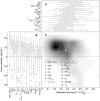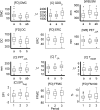The Changing Strength and Nature of Fire-Climate Relationships in the Northern Rocky Mountains, U.S.A., 1902-2008
- PMID: 26114580
- PMCID: PMC4482589
- DOI: 10.1371/journal.pone.0127563
The Changing Strength and Nature of Fire-Climate Relationships in the Northern Rocky Mountains, U.S.A., 1902-2008
Abstract
Time-varying fire-climate relationships may represent an important component of fire-regime variability, relevant for understanding the controls of fire and projecting fire activity under global-change scenarios. We used time-varying statistical models to evaluate if and how fire-climate relationships varied from 1902-2008, in one of the most flammable forested regions of the western U.S.A. Fire-danger and water-balance metrics yielded the best combination of calibration accuracy and predictive skill in modeling annual area burned. The strength of fire-climate relationships varied markedly at multi-decadal scales, with models explaining < 40% to 88% of the variation in annual area burned. The early 20th century (1902-1942) and the most recent two decades (1985-2008) exhibited strong fire-climate relationships, with weaker relationships for much of the mid 20th century (1943-1984), coincident with diminished burning, less fire-conducive climate, and the initiation of modern fire fighting. Area burned and the strength of fire-climate relationships increased sharply in the mid 1980s, associated with increased temperatures and longer potential fire seasons. Unlike decades with high burning in the early 20th century, models developed using fire-climate relationships from recent decades overpredicted area burned when applied to earlier periods. This amplified response of fire to climate is a signature of altered fire-climate-relationships, and it implicates non-climatic factors in this recent shift. Changes in fuel structure and availability following 40+ yr of unusually low fire activity, and possibly land use, may have resulted in increased fire vulnerability beyond expectations from climatic factors alone. Our results highlight the potential for non-climatic factors to alter fire-climate relationships, and the need to account for such dynamics, through adaptable statistical or processes-based models, for accurately predicting future fire activity.
Conflict of interest statement
Figures







References
-
- Meehl GA, Stocker TF, Collins WD, Friedlingstein P, Gaye AT, Gregory JM, et al. (2007) Global Climate Projections In: Solomon S, Qin D, Manning M, Chen Z, Marquis M et al., editors. Climate Change 2007: The Physical Science Basis Contribution of Working Group I to the Fourth Assessment Report of the Intergovernmental Panel on Climate Change Cambridge, United Kingdom and New York, NY, USA: Cambridge University Press.
-
- Flannigan MD, Krawchuk MA, de Groot WJ, Wotton BM, Gowman LM (2009) Implications of changing climate for global wildland fire. International Journal of Wildland Fire 18: 483–507.
Publication types
MeSH terms
LinkOut - more resources
Full Text Sources
Other Literature Sources
Medical

